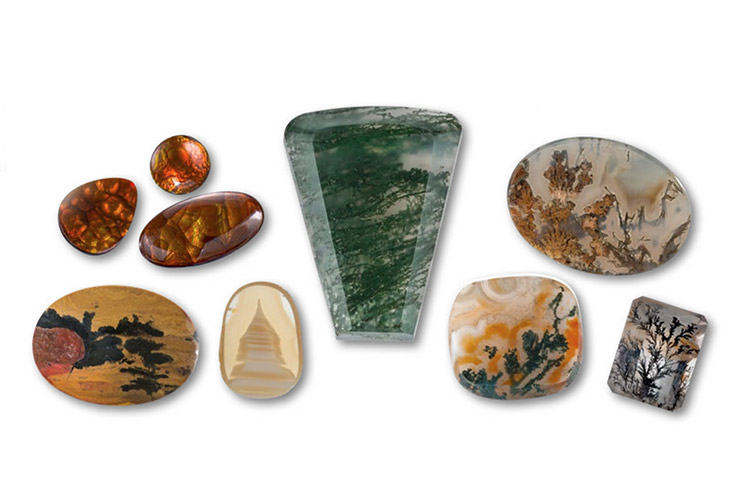Guide to Chalcedony

History, Lore and Appreciation
Chalcedony is a significant form of microcrystalline (or cryptocrystalline) quartz, which has dozens of varieties and colors. Chalcedony has been enjoyed and used in jewelry for thousands of years. Some estimates gauge the use of chalcedony (in carvings such as seals) and other ornaments as far back as the Bronze Age, circa 1800 BCE. Though subject to interpretation, a more recent record for chalcedony dates back to the Israelites’ exodus from Egypt (ca. 5-6th century BCE) where at least three varieties of chalcedony are described in the High Priest’s Breastplate jasper, chrysoprase and sardonyx. Other agates were possibly also used.
Here is some of the principal chalcedony trade names used in jewelry today:
Agate – The word “chalcedony” is sometimes used interchangeably with the word agate, though agate generally describes curved or angular- banded varieties of chalcedony.
Amethystine – Semi-translucent to opaque purple color.
Bloodstone – A dark green semi-translucent to opaque cryptocrystalline quartz containing dark green body color (colored by actinolite) with deep red spots. It has also been referred to as heliotrope.
Carnelian – Semi-transparent to translucent yellow orange to orangey red or brownish orange material.
Chrysocolla-in-chalcedony – Translucent to semi-translucent intense light blue or blue green, owing its color to chrysocolla, a copper silicate.
Chrysoprase – Translucent to semi- translucent, light to medium yellowish green caused by nickel-related impurities.
Dendritic Agate – Chalcedony containing dark, branch-like or tree- like inclusions.
Fire Agate – Semi-translucent to opaque botryoidal chalcedony with iridescent phenomena against a brown body color.
Landscape Agate – A chalcedony, often with a layered structure, containing trace elements that
add color and inclusions (such as dendrites). Properly oriented during the cutting process, these agates resemble landscapes.
Iris Agate – A rare, semi-transparent to translucent agate, exhibiting phenomenal iridescent colors when light, especially pinpoint lighting, is transmitted through a slice of this material.
Jasper – Translucent to opaque microcrystalline material, that may be any color or combination of color – except black.
Onyx – Generally opaque, banded chalcedony. The parallel layers of chalcedony are black and white.
Prase – Semi-transparent to translucent green color caused by mineral inclusions (e.g. actinolite, chlorite).
Sard – Semi-transparent to translucent dark brownish red to brown or dark orange, but less saturated in color than carnelian.
Sardonyx – Semi-transparent to translucent dark brownish red to brown or dark orange, but less saturated in color than carnelian, containing concentric white and reddish banded parallel layers.
Birthstones and Anniversaries
Bloodstone is an alternate birthstone for the month of March. Onyx is suggested as a 7th wedding anniversary gemstone.
Description and Properties
Chalcedony has a chemical composition of SiO2 and forms as an aggregate material. Some chalcedony grows in
a botryoidal formation.
Refractive Index: 1.535 to 1.539 Birefringence: usually not detectable. Specific Gravity: 2.60 (+0.10, -0.50) Cause(s) of color:
Carnelian: Body color due to iron impurities. Chromium may be present in redder colors.
Chrysocolla Chalcedony: coloration normally due to impurities of copper minerals.
Chrysoprase: coloration normally due to nickel-related impurities.
Fire Agate: Body color due to iron impurities.
Sard: Body color due to iron impurities. Chromium may be present in redder colors.
Mohs Hardness: 6.5 to 7
Internal identifying characteristics: Inclusions of other minerals. Thick bands of color often characterize chalcedony. Dendritic inclusions are seen in chalcedony as well.
Treatments
Dyeing – Chalcedony can be dyed in practically all colors, due to its porous nature. Bleaching may be combined in the treatment process to remove color. Much of the black chalcedony sold on the market is treated black. In banded material, some more porous bands may be dyed while others retain their natural color.
Heating – Some yellow to brown material may be heat-treated to result in deeper red colors.
Collector Quality
Chalcedony exhibiting unusual banding or landscape scenes is particularly prized, as are agates containing dramatic dendritic inclusions. Slabs of iris agates and cabochons or free form fashioning of fire agate exhibiting strong iridescent colors are also collected. Finally, carved chalcedony, such as intaglios or cameos, may be collectible if they have provenance that can be identified as typical of a certain era. Signed gems from a known lapidary artist are also collectible.
Localities
Germany (historical source), Brazil, India, Russia, Australia, Austria, Scotland, Italy, Mexico, USA.
Cutting, Care and Cleaning
Chalcedony is a gem composed of cryptocrystalline and microcrystalline (microscopic) quartz crystals that form in tightly interlocking, fibrous masses. This provides chalcedony with extraordinary toughness, allowing it to be carved in cabochons, intaglios, cameos, tablets or even plates or bowls. ldar-Oberstein, twin cities in Germany, have been known for developing the cutting and carving industry for this gem since the 15th century. Artists there carved local chalcedony but began to import agate from Brazil in the 19th century as supplies dwindled in Germany.
Chalcedony is very durable in general, but special care should be taken not to subject it to temperature extremes. It may be cleaned in an ultrasonic cleaner, if it is clear and there are no fissures that could endanger the durability of the stone.
Source: CIBJO Retailer Reference Guide, cibjo.org. Image: American Gem Trade Association